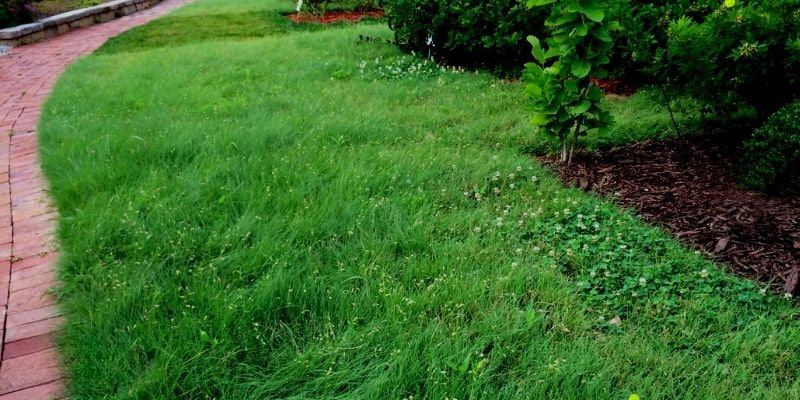Let’s discuss the advantages and drawbacks of buffalo grass.

What are the benefits and drawbacks of buffalo grass? The vibrant green color that this grass provides to your lawn is undoubtedly its most eye-catching feature. Proper care of these grasses is essential if you want to make the most of their potential to enhance your lawn’s aesthetic value. Unfortunately, there are also some negative aspects.
You must understand the benefits and drawbacks of buffalo grass in order to use them effectively. To that end, let’s weigh the benefits and drawbacks of buffalo grass so that we can make the most of its positive qualities.
Table of Contents
Buffalo Grass Pros and Cons
Buffalo grasses are resilient and dark green no matter the season. These grasses can survive in chilly conditions because they are resistant to heat, drought, and even frost. In this light, familiarity with their benefits is crucial.
The Benefits of Buffalo Grass
Drought resistance: A prolonged drought will not kill buffalo grass. These grasses go dormant when they can’t find any water, allowing them to stay alive until rain returns. After a long period of dehydration, it will quickly recover once it finds water and consumes enough of it.
Low height
The aesthetic value of a lawn is diminished by overgrown grass, which also depletes the soil of its nutrients and harms the other lawn plants. Wild buffalo grasses are limited to a height of 8 inches. Depending on the type, these grasses can reach a height of anywhere from 3 to 8 inches.
Low nutrients requirement
Buffalo grasses require fewer nutrients because they grow more slowly. Maturated buffalo grass needs only 1 to 2 pounds of nitrogen per year for every 1,000 square feet. Therefore, it drastically cuts down on the amount spent on upkeep.
Low insect attack
Bugs that feed on buffalo grasses are uncommon. The buffalo grass chinch bug is a well-documented pest.
Tolerant to weather conditions
Buffalo grasses have a well-deserved reputation for heat resistance. So that it flourishes even in the hottest summer months. These grasses can withstand freezing temperatures as well. The effects of strong winds on them are minimal.
Lively Green Color in Late-Season
Even when it’s late in the season, buffalo grasses maintain their bright green color. Because of this, these grasses retain their attractiveness throughout the year.
Buffalo Grass’s Drawbacks
Buffalo grass disadvantages are minor when considering its use in landscaping, but they are worth considering.
Expensive
Buffalo grass seed and sod are more expensive than other types of grass or turf, but the upkeep is minimal. Growing buffalo grasses requires a sizable initial investment, which should be taken into account.
Prefer dry climate
Buffalo grasses can survive in arid, hot, or cold environments. Buffalo grasses, however, have a strong preference for and thrive in drier climates. In keeping with its native Great Plains, buffalo grass thrives in arid climates and prolonged periods of warm weather.
Northern areas have a short growing season.
Western states, from West Texas to California in Western Canadian Province, are where buffalo grasses are most at home. The majority of buffalo grass species struggle to thrive in areas with heavy precipitation.
To put it simply, the north is notoriously chilly. When temperatures drop in the north, buffalo grass turns brown, even though it can remain green in the south well into the fall. It’s because it goes into hibernation when temperatures drop significantly. Certain types of buffalo grass struggle to thrive in colder climates. They are not hardy in cold climates and do not hibernate during the winter.
Less dense varieties
When compared to newer varieties, older buffalo grasses tend to grow more sparsely. Despite the abundance of seed pods, the plant’s thinning, unattractive appearance puts off most observers.
Thin
In comparison to other types of turf grass, buffalo grass is too thin. Buffalo grasses are much more narrow and unattractive than other types of grass, such as Zoysia.
Tips for Selecting Buffalo Grass
Many types of buffalo grass exist, so it’s important to find one that thrives in dense turf.
You should use buffalo grasses on your lawn if you live in the northern plains. Choose the best grass for your area with the help of the local extension service.
Frequently Asked Questions (FAQs)
Does buffalo grass make a good lawn?
Yes, Buffalo grasses, with their vibrant green color and short, mowed appearance, can make a lovely lawn. Buffalo grasses are great for landscaping because they require little care, thrive in a variety of conditions, and look great year-round.
What advantages does buffalo grass have?
Numerous positives can be attributed to buffalo grasses. If you plant these grasses in the north, they’ll stay a gorgeous dark green all year long. They can withstand extremes of temperature and humidity without wilting. They can survive freezing temperatures by entering a dormant state.
Does buffalo grass spread quickly?
While some older buffalo grass varieties may grow slowly, newer, more vigorous varieties flourish in the spring. These varieties retain their deep green color even as autumn approaches. A fast-growing stolon network allows them to quickly take over a new area.
Conclusion
If chosen carefully, buffalo grasses make excellent ornamental lawn grasses. So, it’s important to weigh the benefits and drawbacks of buffalo grass. In defense of these grasses, they require little in the way of upkeep or nutrients, as argued by their proponents. They can withstand extreme temperatures and moisture levels. This means that you can use these grasses to great effect in creating an attractive lawn.
However, there are some drawbacks to using buffalo grasses that must be considered. You should pick a wide variety of buffalo grasses, each of which is optimal in a different climate and at a different time of year.




